Hello everyone:
As always, please remember to scroll past the end of the essay to read some curated Anthropocene news.
Now on to this week’s writing:
In my little Maine town, three large solar arrays are under construction. Two of them are commercial projects, and the third is a community solar project that Heather and I will sign up for. We’ll get cleaner energy and a slightly discounted electric bill. This is good news, but as so often happens in this era, even the good news is complicated and a bit ugly.
One of the commercial projects, at 12 acres, is being built in a gravel pit. That’s good use of a wasteland that had little prospect of rewilding. The other commercial site and our community array, at 33 acres and 12.7 acres respectively, have been carved out completely from healthy forest. That’s nearly 46 acres of clear-cut habitat, now fenced and relatively lifeless, to serve a single purpose: powering a tiny fraction of the grid. See the picture above for an idea of the current price of “clean” energy.
We may need to convert as much as 250,000 square miles of U.S. land to renewable energy production. That’s the size of Texas. (More on that in a bit.)
One of the defining characteristics of this era is the tension between our technology and our ethics. (The problem might seem specific to the ethics of our technology, but that’s blaming the tools rather than the hands that build and wield them.) Our lives are now bounded by this tension and its consequences. As the planet heats and as plants and animals suffer – with human society hanging in the balance – we’re desperately trying to implement solutions. The energy revolution that’s coming is both necessary and long overdue, but it’s a more complicated savior than we would like to admit.
Clean energy has a dirty footprint. Largely this is a consequence of civilization waiting far too long to respond to fossil-fueled disaster. We have too much to do and no time to do it. The atmosphere and the oceans are far too hot, and we ain’t seen nothing yet. To speed things up, sacrifices are being made, but we should remember that many of these sacrifices are the same ones we’re trying to avoid: contamination and pollution, habitat loss and extinctions, global inequity and child labor, etc.
Any solution that shares features of the problem it’s trying to solve reveals two things: 1) It’s a sloppy solution, and 2) we think we don’t have a choice.
The Anthropocene (the age of planetary human impact) might be better described as the Pyrocene (the age of uncontrolled combustion), the Crowdocene (the age of uncontrolled population growth), the Capitalocene (the age of profit-driven destruction), and the Loneliocene (the age of our isolation from nature), all rolled into one.
A more elegant way of saying all this is we’ve forgotten how to live. Or perhaps it’s more accurate to say that we’ve never learned how to apply the wisdom of ordinary human life to large-scale civilization. We forget that we’re integrated into the web of life, convinced instead that we own it.
Perhaps, at this scale, it’s inevitable that there’s too much concentrated power, too much investment by selfish people with selfish goals, and too much acquiescence by the quiet majority who are neither selfish nor powerful. We will see, and soon.
Even when such a civilization lurches toward wisdom (driven, let’s be clear, by a belated realization of its own fragility) it will struggle to avoid making its usual mistakes and causing the usual extraordinary damage. However gentle our individual souls, from the point of view of the rest of life on Earth we are a very hungry caterpillar with eight billion heads.
As an example of the lurching, let’s look at how the global roll-out of utility-scale solar power is going.
Energy from the Sun falls unselfishly upon the whole Earth, generating all of life. To capture it, we’re building massive solar arrays on land that we often first wipe clean of life. I think it’s fair to say that erasing habitats to capture electrons for our own purposes is only marginally more ethical than erasing habitats by burning millions of years of stored oily carbon for our own purposes.
In the long-term, of course, solar will have a cleaner footprint and will actively reduce our greenhouse gas emissions year after year, which will in turn save billions of non-human lives. Climate activists and solar proponents may acknowledge the “growing pains” of rapidly rolling out solar arrays and a more muscular electric grid in a world that’s lost so much life already, but they argue that the net gain in planetary health justifies the work.
That’s the argument I want to tussle with here.
To be clear, I’m an enthusiastic advocate for solar power. Paired with sensible energy storage, solar is the most rational way to power the modern human experiment. (Fusion power, as I’ve written, may be a better source of centralized power and will likely someday replace wind and solar, but not for a while.) How we implement solar, though, needs to be talked about at every level of policy.
The climate wars have blinded us to the equally important biodiversity battle, as David Wallace-Wells has explained in the Times, noting that the climate-focused environmental movement has grown “less attached to the natural world for its own sake and more invested in efforts to limit temperature rise for the sake of human flourishing.” More bluntly, Christopher Ketcham at the Intercept, in an article titled “Addressing Climate Change Will Not ‘Save the Planet,’” writes that
Taking up this banner of optimistic can-do-ism, the environmental movement has convinced itself, and sought to convince the public, that with a worldwide build-out of renewable energy systems, humanity will power its dynamic industrial civilization with jobs-producing green machines while also — somehow — rescuing countless species from the brink.
“But this happens to be a lie,” [Dan Ashe, director of the U.S. Fish and Wildlife Service under President Barack Obama] told me. “The lie is that if we address the climate crisis, we will also solve the biodiversity crisis.”
As I’ve been saying here in the Field Guide for two years now, the climate catastrophe is only one symptom of the larger problem: We are rapidly erasing much of life on Earth. A million species are at risk of extinction in the near future. And this begs the question of how much more sacrifice of species and ecosystems is acceptable for solar panels or windmills or transmission lines. This topic – to what degree addressing climate change also addresses the threats to life on Earth – needs its own essay or two. For now, then, think of it as the context for how we should implement our new clean energy infrastructure.
There’s a nice readable version of the we-need-to-sacrifice-for-solar argument in a 2021 blog post by Kate Cell, the Senior Climate Campaign Manager for the Climate and Energy Program at the Union of Concerned Scientists. Cell’s post, “When Slowing Global Warming Means Cutting Down Trees: Hard Choices in the Climate Crisis,” is rooted in the forest behind her home in western Massachusetts, where a 190-acre clear-cut was being proposed as part of what would become the state’s largest solar array.
It's worth reading, but the gist is this: Climate math trumps concern for wildlife and ecosystem health. In this math, forests are evaluated for how much they can help with climate change, not for the inherent value of the lives they contain. Here’s a sample: “…every year, the solar panels would avoid emissions of 5,146 tons more CO2 per year than the 190 acres of forest could sequester. Those 5,146 tons represent the annual CO2 emissions of about 1,123 cars.”
The math is framed by Cell’s awareness of the terrible consequences of a burning world for all life, but there’s no biodiversity or extinctions in her math, and there’s no insistence that developers first seek less harmful options. Why clear-cut 190 acres if some or all of a project can share space with parking lots, rooftops, landfills, or utility corridors? Cell is wise enough to say she wants those sites used as well, but insists that we need an all-of-the-above approach and we need it now. To make her point, she makes a compelling climate argument:
We have left it so late to act on climate, to reform our profligate ways with our planet and our atmosphere, that many choices will be complex, and fraught, and painful, from here on out. But here’s the thing: the climate we have today, with its stronger storms and heavier downpours, its hotter heatwaves and fiercer wildfires, its rising seas and melting glaciers, is as good as it’s going to get for a very long time.
I share her fear, but there’s a difference between a painful choice and a counterproductive one. For solar, we need a policy shift now, before our painful choices create more pain. Federal, state, and local governments need to prioritize and incentivize multi-use sites in the permitting of solar arrays. Why, in the midst of a dual global crisis – biodiversity and climate – would governments give permission for solutions to one crisis which will only worsen the other?
It always surprises me that the people who understand the imperative of immediate action on climate aren’t equally aware that we’re also reaching the limit of ecological damage we can get away with without critical Earth systems breaking down. Can’t they see how the crises intertwine?
I wrote about the necessity of addressing both crises at once in a two-part essay called A Flat Tire and a Dead Battery. The title comes from the director of the Campaign for Nature during the 15th U.N. Biodiversity Conference:
When you have two concurrent existential crises, you don’t get to pick only one to focus on – you must address both no matter how challenging… This is the equivalent of having a flat tire and a dead battery in your car at the same time. You’re still stuck if you only fix one.
I offered a thought experiment in that writing, which (with some edits) I’ll repeat here:
Imagine that all of a sudden – poof! – we flicked a switch to stop overheating the Earth and flicked another – poof! – to suck the excess CO2 out of the atmosphere. While we’d lose the terrifying multiplier effects of a hotter, drier, more turbulent planet on the already increased rate of extinctions, that increased extinction rate would still be there because its other causes would still be there: industrial agriculture, chemical and plastic and nutrient pollution, ocean acidification and deoxygenation, habitat loss, invasive species, and much more. As just one example, North American grassland birds have lost over 50% of their breeding population in the last fifty years because of habitat loss and pesticide use. Keeping global warming below 1.5°C will help the remaining birds, but it won’t slow the loss from the main causes.
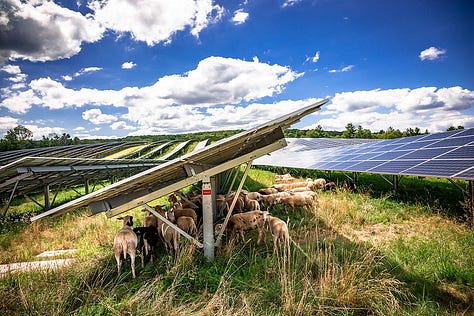
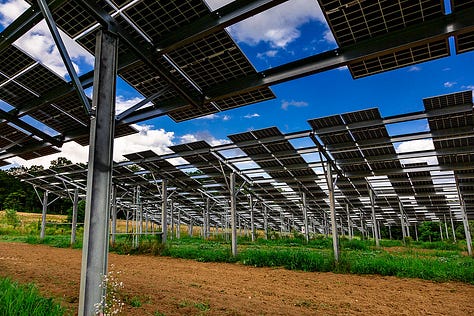
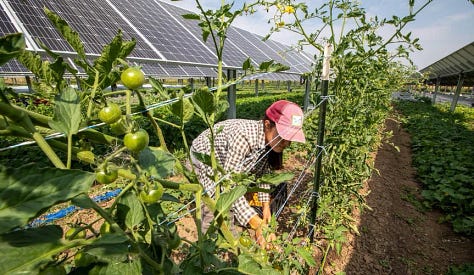
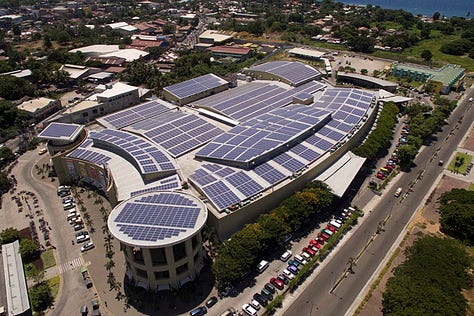
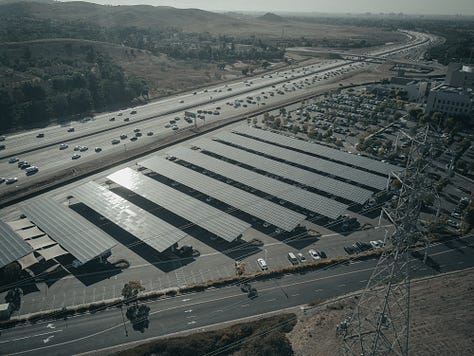
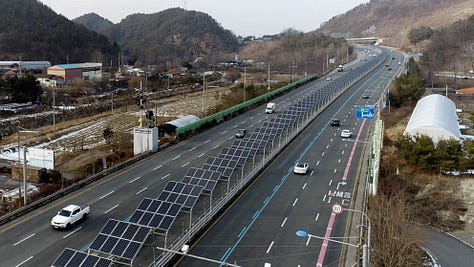
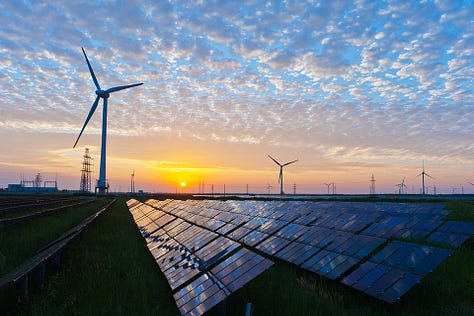
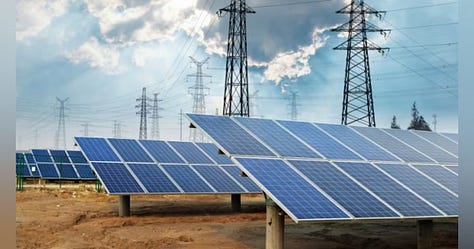
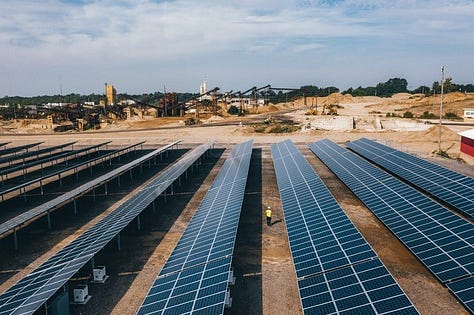
What are the wiser solutions for solar? They fall into two categories: where we put the panels, and how we incentivize that placement.
As the photos above indicate, there are many great places to site panels alongside or on top of other human landscapes. Some of these are urban or industrial: warehouse/factory/mall/box store rooftops, parking lots, power line corridors, highway medians, bike lanes, abandoned mines, gravel pits, brownfields, and landfills. Some are rural or agricultural, with panels placed alongside wind turbines or atop productive farmland full of crops or grazing animals.
Agrivoltaics, as this latter practice is called, is new but catching on. The benefits can be significant for both the farm and the panels. The panels provide an extra source of farm income while offering shade to farm workers. Sheep and other grazers benefit from the shade, too, even as the panels improve shade-tolerant crop production. In hot, dry environments green crops cool the panels, making them more efficient, while the panels reduce evaporation and the need to water. Panels also protect crops from strong winds and heavy precipitation. For a solar developer, arrays on farmland can be cheaper to build because the land is already flat and ready to use.
In general, the priorities for solar installations should be to a) do no environmental harm, and b) create multi-use sites. At this stage of the Anthropocene there is simply no good reason to cut down a forest or damage a wetland for single-use energy production. A selfish array of solar panels is the result of hasty planning and poor policy.
But that seems to be the most common policy we have right now.
Guidance seems hard to come by, existing only in patchwork fashion. As the Chesapeake Bay Foundation writes, “…better placement of solar projects starts with local municipal governments having up-to-date local comprehensive plans and ordinances that direct solar farms away from forests and farmland, streams, and wetlands.” (Their concern about farmland in the report has to do with solar arrays displacing necessary agricultural production.) In response, CBF produced a useful Principles and Practices guide for its region. Likewise, here in Maine, there’s a good Best Practices guide from Maine Audubon and Maine Farmland Trust, but the state doesn’t have a regulatory framework that pushes solar developers away from healthy habitat or that prioritizes dual-use or multi-use siting.
The Nature Conservancy (TNC), though, has just released a report called The Power of Place – National, which is meant to help state and local governments across the country “build the clean energy infrastructure needed for economy-wide, net-zero emissions by 2050 while avoiding most impacts to sensitive natural and working lands.” The TNC report is wonkier than it should be for general consumption, but I’m happy to see that it highlights agrivoltaics, co-location of wind and solar, and the importance of avoiding sensitive or otherwise healthy habitat.
The bad news is that by current estimates the U.S. needs a build-out of renewable energy that will take up 250,000 square miles. As I noted earlier, that’s the size of Texas. The good news is that with the strategies TNC recommends, it’s possible to reach a 70% reduction in environmental and social impacts and reduce the build-out to an estimated 115,000 square miles. That’s merely the size of Arizona…
Put another way, estimates suggest we need 3,100-3,500 gigawatts (GW) of renewable energy production by 2050. We’re currently producing a bit more than 200 GW of wind and solar, and recent analysis suggests we might reach a “staggering” 600 GW by 2030. There’s a long, long way to go. Picture that Texas- or Arizona-sized area of solar and wind installations, and you get the idea. You can also understand why I think it’s vital now that we have good guidance for the mad rush that’s coming.
At a planning board meeting for our community solar project, an environmental consultant was asked about the logic of clear-cutting healthy forest for a solar array. He provided a math-less version of the standard carbon math answer:
On the whole, it’s primarily an environmental benefit. A lot of times we get questions regarding tree-clearing. They look at trees sequestering carbon, kind of viewing that as potentially a loss. But ultimately these facilities provide far more benefit.
It’s a logical answer, but the logic only works if we’re ignoring the big picture. This is “environmental” thinking that has lost touch with the environment.
I was glad to see that our community solar site has sought certification from the National Wildlife Foundation, though having seen the clear-cut, fenced-in, scraped-bare site I’m not sure how they plan to meet the requirements for food, water, and habitat. Perhaps they’ll focus on helping pollinators. It has occurred to me that if our new “clean” energy sources are going to keep shaking the biological Etch-A-Sketch and erasing life before collecting electrons, they should at the very least be required to establish pollinator-friendly plantings throughout the facility. There’s simply no good reason for solar panels to live lonely and selfish lives, and bees make good company.
Thanks for sticking with me.
In other Anthropocene news:
From Yale e360, an interview with Chilekwa Mumba, a Zambian activist who successful sued a UK-based mining firm for their copper-mining contamination of communities and their environment. The larger importance here is that this case “set a legal precedent that British companies can be held accountable for the environmental fallout of their operations overseas.”
From Common Dreams, deforestation in Brazil was down 68% in April compared to a year ago. This is largely due to the election of Lula and his environmental promises and policies. While this is very good news, though, it still reflects the bad news: 127 square miles of the Brazilian Amazon were cleared last month.
From the Guardian, the cost to human society from PFAS “forever chemicals” is an estimated $17.6 trillion dollars. This is an astounding number, but not entirely surprising, given that PFAS are ubiquitous in your life and mine. Some very recent examples in the news: your soft contact lenses are “almost pure PFAS” according to a recent report, and the pesticides used on your food are full of this terrible stuff. As one expert said, “There is no better way to poison Americans than contaminate our food supply and soils with PFAS, and the blame for this lies squarely on the shoulders of EPA.”
From Noema, Kohei Saito, author of Capital in the Anthropocene and a political/economic philosopher in Japan – a country teetering on the brink of degrowth – describes the path all economies must take if the natural and human worlds are to survive and evolve together:
Saito warns against the illusion that humans can escape the limits of our condition through a technological fix that somehow accommodates both “sustainability” and “development.” Inexorably, technology harnessed to the logic of GDP growth only further propels and accelerates the ruinous course we are already on, not departs from it.
From Nautilus, “The Oceans Are Missing Their Rivers.” Among the many, many impacts of dams, here’s one that’s been less studied: the loss of sediment moved from land to sea. As sediment flow declines, so do the rebuilding of deltas and the flow of nutrients out into a hungry sea. Major ocean currents which relied on freshwater input have changed. There are nearly 60,000 big dams (defined as 50 feet or higher) and much of the pre-industrial flow of rivers has been already lost.
From Inside Climate News, one of the many tragedies of severely declining seabird populations is the loss of their contribution to nutrient cycling in the oceans. Restoring seabirds would help restore ocean ecosystems and fight climate change because more robust marine ecosystems store more carbon in marine sediments.
From The Nature Conservancy, the 32-page “Power of Place” report is meant to serve as a guide for communities, cities, and states as they plan how to improve and expand U.S. energy infrastructure. Importantly, the goal here is to protect biodiverse habitat as a major climate-focused energy agenda gets underway. It is absolutely critical that striving to reach climate goals does not worsen biodiversity losses. Any solution must be a solution for both. Download the report for details.
From the Times, an important debt-for-nature swap. Ecuador has struck a deal with a major bank to put hundreds of millions of dollars into Galapagos conservation in exchange for a one-billion-dollar reduction in its debts. This is a good first step in what should be a global effort to simultaneously reduce the debts of poorer nations and increase their conservation of land and sea.
From Hakai, a good news story from Hawai’i, where a traditional stewardship and conservation system known as ahupua’a is being revived. Working with U.S. agencies, three communities on O’ahu, Kaua’i, and Hawai’i are working to protect and revive the natural communities that live between mountains and the sea.

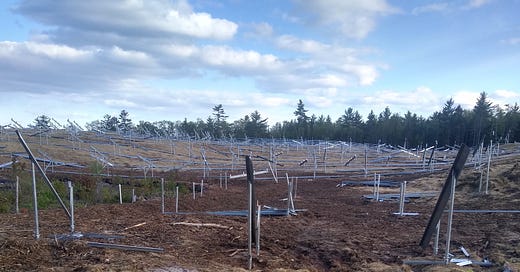




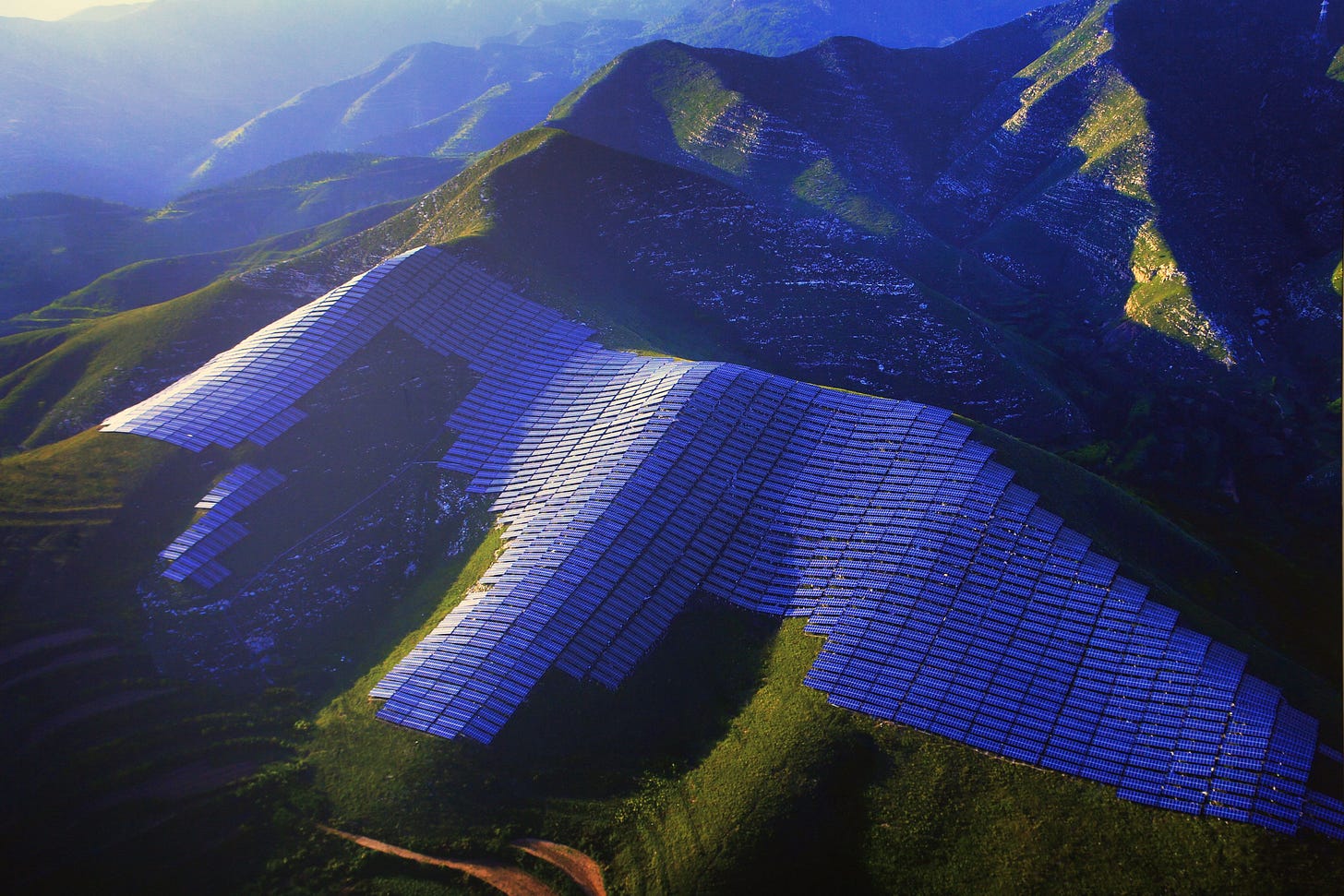
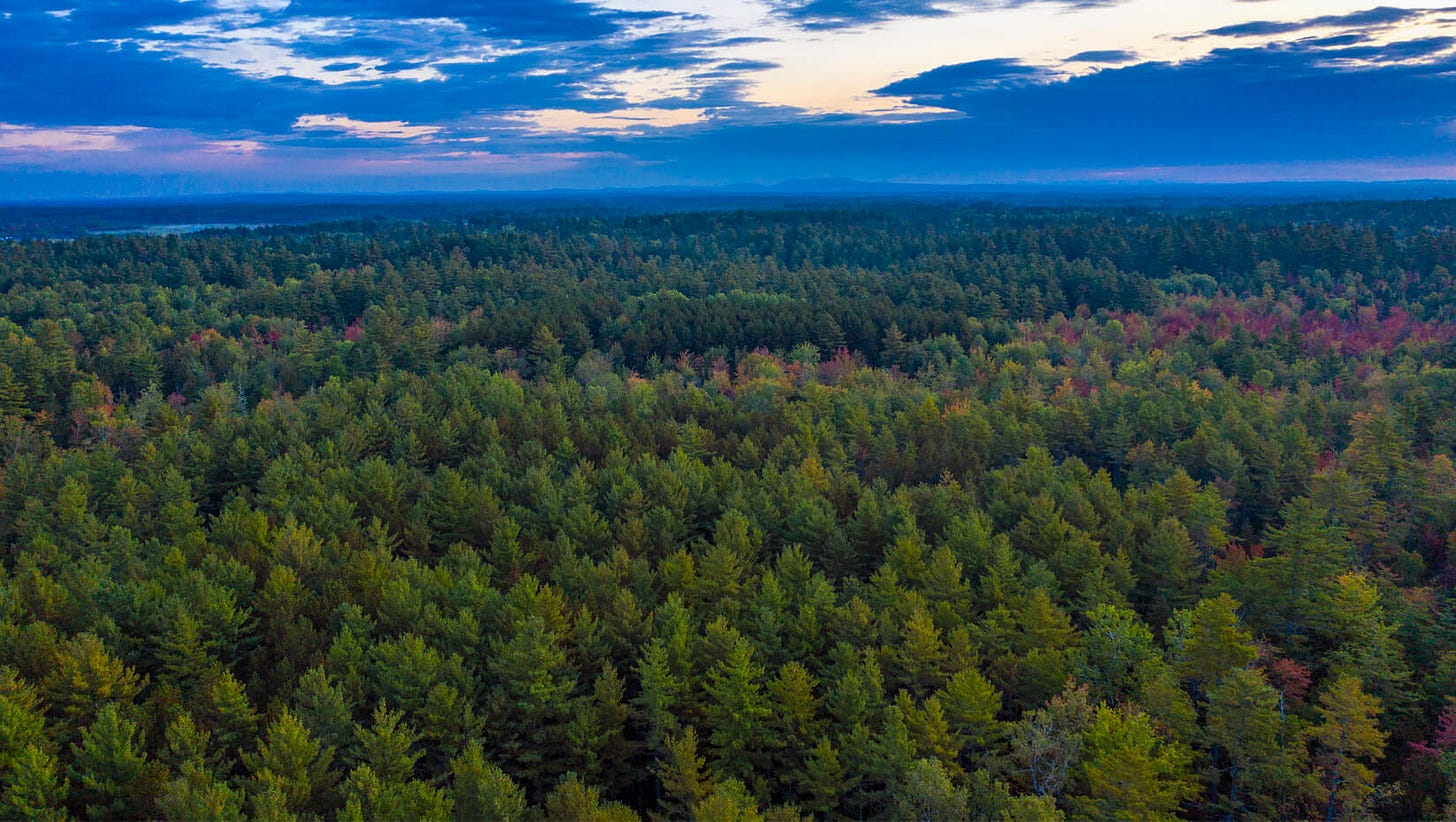

Happy to see this thought process. We have been creating habitat for pollinators in solar fields since 2015. When we started the importance of addressing biodiversity loss in these spaces was an afterthought embraced only by the most progressively-minded Solar developers. We now have over 30 solar Fields in four states including Maine. It's important to recognize that this process is not simply 'set it and forget it' but requires fastidiousness to avoid tossing down wildflower seeds in a space where invasive species, including native opportunists, will result in only a short term success. Optimal strategies include site selection that embraces protecting diverse habitats from development and measuring sites for positive impact across the lifespan of the project. Mike Kiernan beethechange.earth
I so appreciate this article. I myself feel torn between hard choices when it comes to becoming more energy efficient.